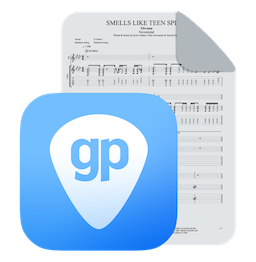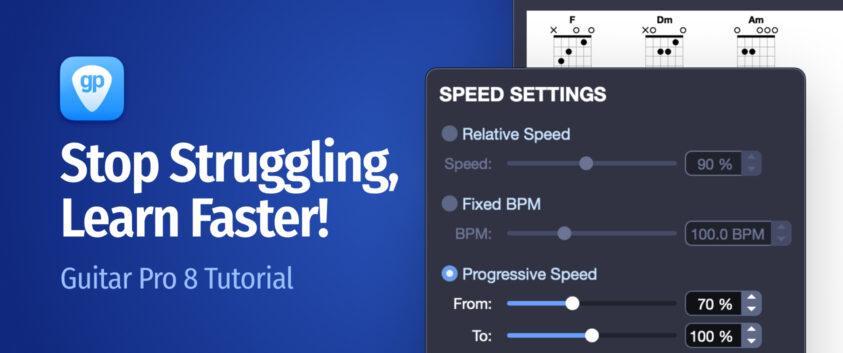
How to Learn a New Song Fast on Guitar with Guitar Pro?
- The Best Tips for Learning a Song Quickly with Guitar Pro
- 1. Download Guitar Pro to access a comprehensive tool for guitarists
- 2. Get the song’s tab to visualise and read the score
- 3. Review the chords and practise playing them to improve transitions
- Chord diagrams in Guitar Pro
- Chord library
- 4. Review the rhythms of the song
- Tab displayed with the rhythmic notation
- Slash notation for chord grids
- 5. Break the song into small sections for more effective learning
- Section markers
- Loop playback
- 6. Don’t hesitate to slow down the tempo to work on difficult passages
- Metronome
- Countdown
- Tempo adjustment
- Guitar Pro speed trainer
- 7. Practise regularly to gradually master the song
- Focus / unfocus mode
- Audio track feature
- Additional Tips to Optimise Your Song Learning on Guitar
- Conclusion
- Your questions
Struggling to learn a new song on guitar? You’re not alone. Every guitarist has experienced the frustration of spending hours on incorrect tabs, stumbling over the same riffs, or simply giving up on that dream song still playing in their head.
Here’s the good news: learning songs faster isn’t about natural talent—it’s about using the right method. In this guide, you’ll discover how to learn a new song fast on guitar using Guitar Pro’s powerful features.
We’ll walk you through a proven 7-step process that transforms frustrating practice sessions into rapid progress. You’ll master essential skills like identifying correct tabs, using the speed trainer effectively, and building a practice routine that actually works.
Ready to learn your favorite songs faster than ever? Let’s dive in!
The Best Tips for Learning a Song Quickly with Guitar Pro
- Download Guitar Pro to access a comprehensive tool for guitarists
- Get the song’s tab to visualise and read the score
- Review the chords and practise playing them to improve transitions
- Review the rhythms of the song
- Break the song into small sections for more effective learning
- Don’t hesitate to slow down the tempo to work on difficult passages
- Practise regularly to gradually master the song
The Best Tips for Learning a Song Quickly with Guitar Pro
1. Download Guitar Pro to access a comprehensive tool for guitarists
If you’re new to Guitar Pro and want to follow along this guide step by step, just download the Guitar Pro 8 demo.
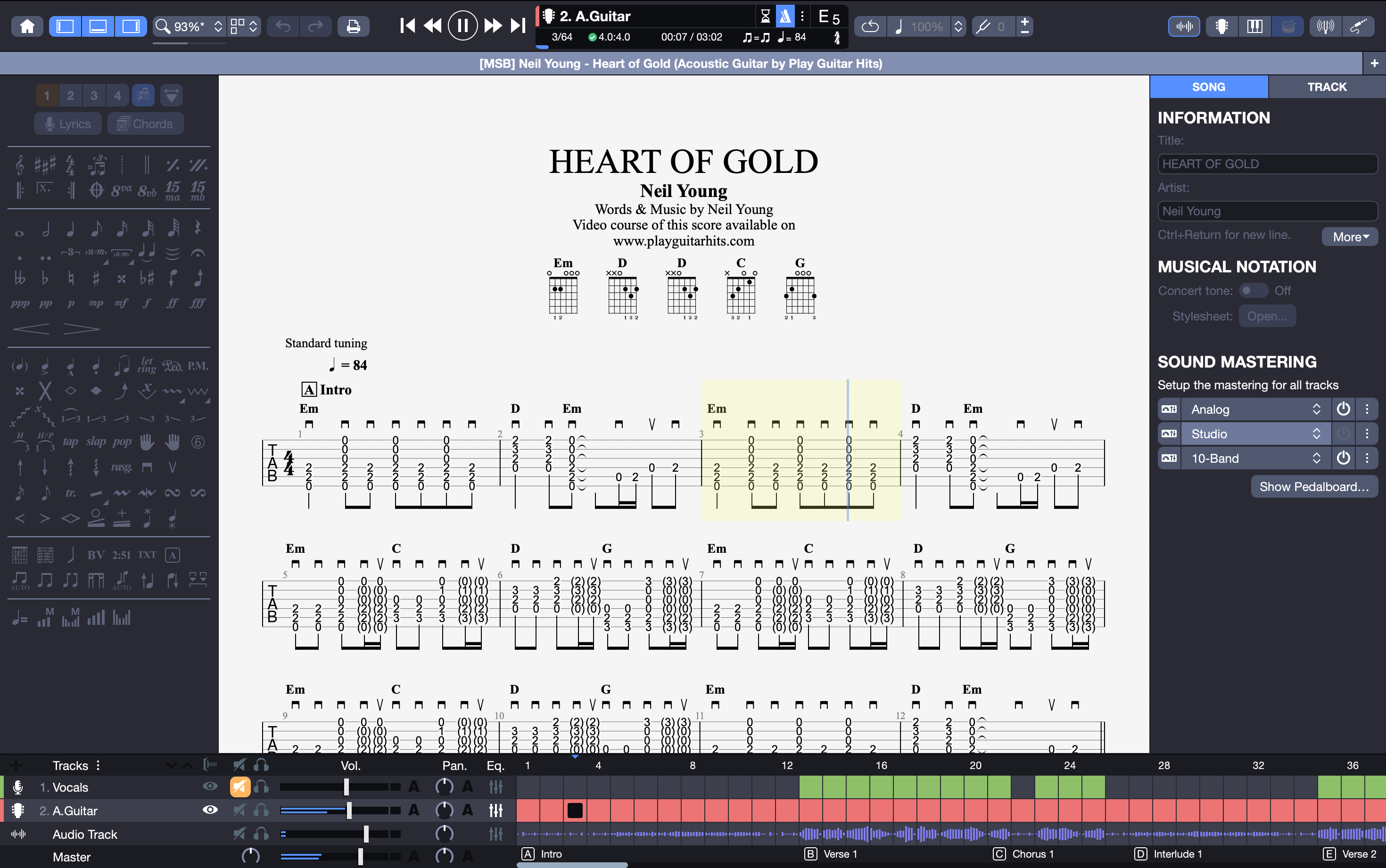
Guitar Pro is the #1 tablature software used by guitarists worldwide. With user-friendly practice features, a realistic sound engine, and professional editing tools, it’s the perfect companion for beginners learning songs faster. Try the free demo today!
2. Get the song’s tab to visualise and read the score
Start by finding a Guitar Pro tab for your chosen song. Simply search online for “[song name] Guitar Pro tab” to find downloadable files shared by musicians and creators worldwide.
Alternatively, explore mySongBook, Guitar Pro’s official library of professionally transcribed tabs, where you can browse thousands of songs by genre, instrument, or type. Subscribers can access the full library directly within Guitar Pro, while everyone can enjoy one free tab daily on our website.
Once you have your file, open it in Guitar Pro and let’s begin!
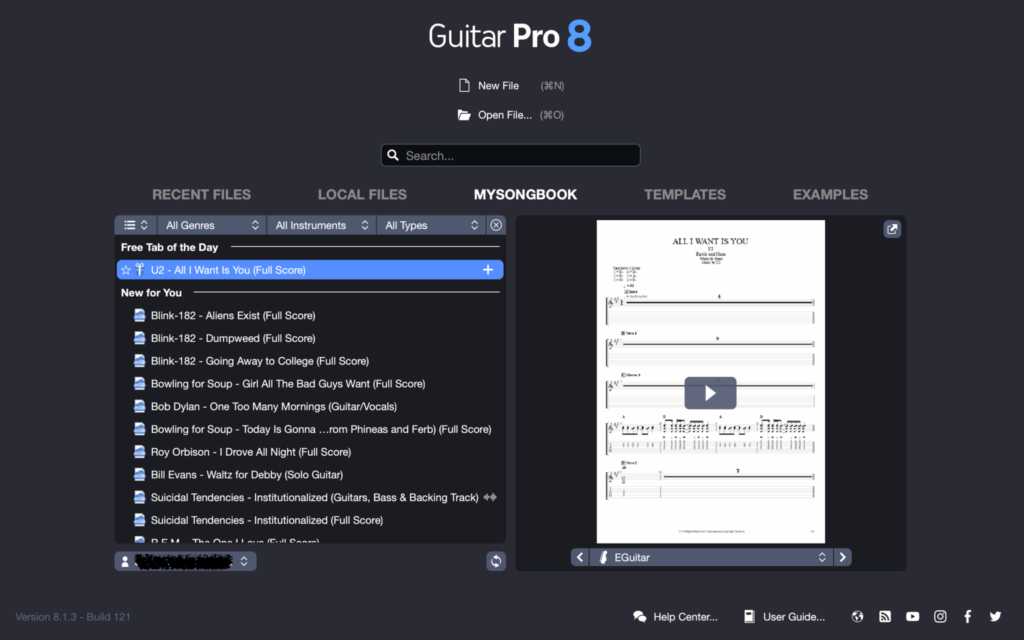
TAB PLAYBACK WITH TABLATURE READER AND RSE SOUND RENDERING OR AUDIO TRACK
Press play, notice how you can follow along the tablature with Guitar Pro’s playback feature, which incorporates a tablature reader, RSE Sound Rendering and audio tracks.
RSE (Realistic Sound Engine) is Guitar Pro’s Sound Rendering system based on our own proprietary sound bank, it’s been specifically designed to offer you the most realistic and pleasant sound experience.
Of course, you can also combine it with MIDI, if you prefer lighter files, and audio tracks for a completely customisable auditory experience.
3. Review the chords and practise playing them to improve transitions
Now that you’re all set up, let’s move on to the nitty-gritty of your practice session. Chords are the basic unit of guitar playing. It’s important to practise playing them individually and consecutively in order to transition between them.
With Guitar Pro 8, you can customise if and how you want chord diagrams to show up in your score, and if you’re scribbling down your own ideas you can access the chord library to help you notate chords and come up with interesting voicings. Here’s how to access CHORD DIAGRAMS and the CHORD LIBRARY:
Chord diagrams in Guitar Pro
You can choose whether you want to see them at the top of your score, in the score or both. You’ll find how to customise chord diagrams following these steps:
- In the right Inspector Panel: Song >Musical notation > Stylesheet.
- In the Stylesheet: Page Score & format > Chord diagrams
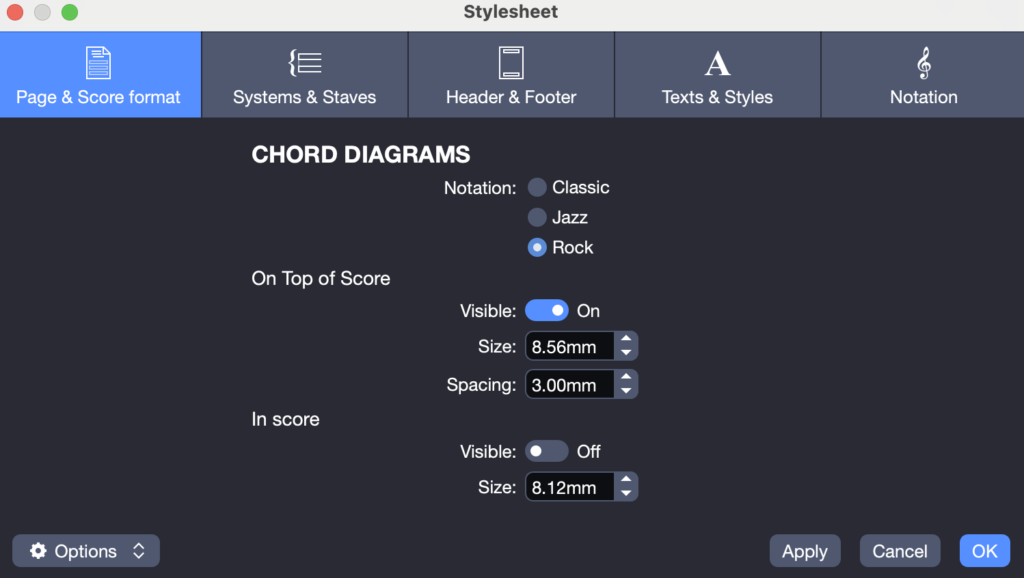
Chord library
Guitar Pro 8 lets you create a chord library individual to each project. Name the chord you want to add, create it from scratch, add alterations, inversions and omissions. To open your Chord Library go to:
- In the Menu Bar (top of your screen) : Note > Chord…
- Alternatively, press “A” on your keyboard to display the Chord view and then press enter to display the chord diagram on your tab
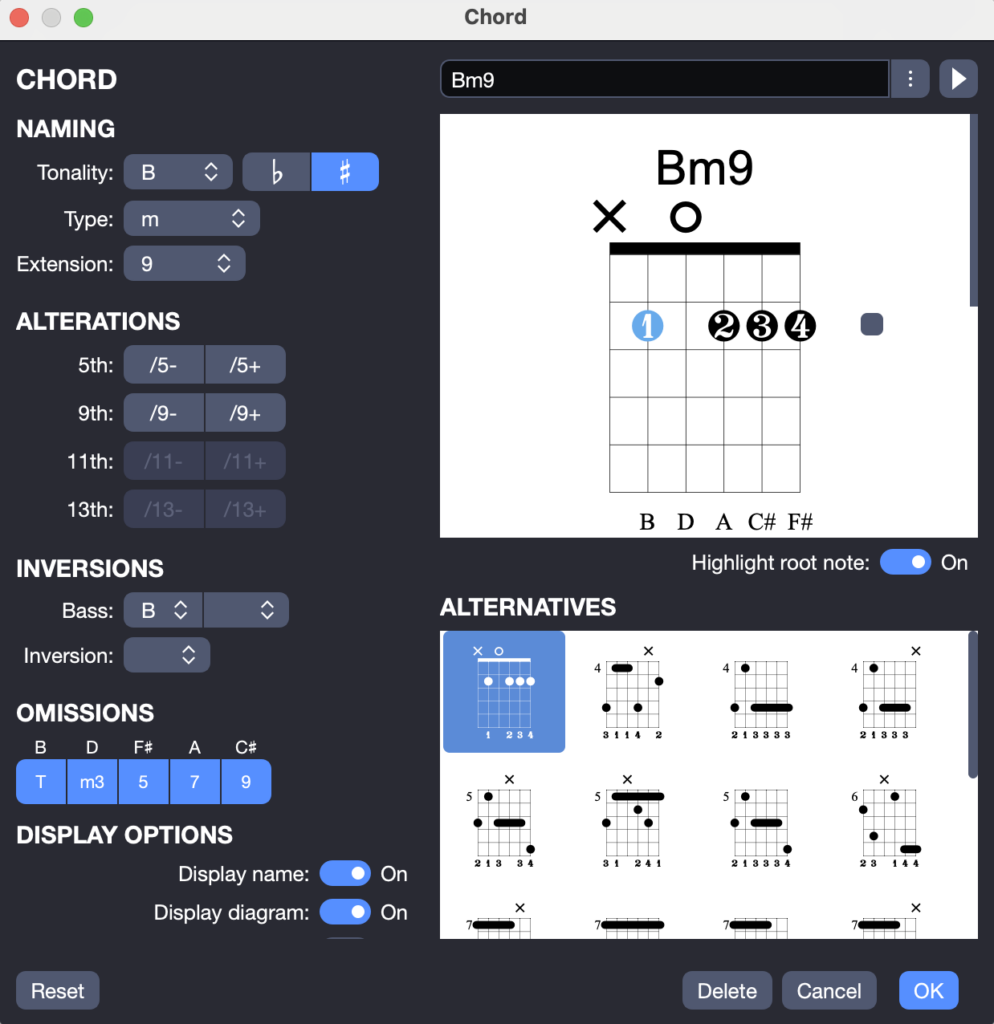
So, once you’ve set up the score in your preferred way, practise the chords for a few rounds, use single downstrokes if necessary, and make sure to get those transitions as clean as possible!
4. Review the rhythms of the song
Now that we’ve practiced chords and transitions we’re onto the next step: rhythms.
In Guitar Pro 8 you can visualise rhythms in various ways, here we’ll show you two of them, but keep in mind, again, it’s fully customisable to each player’s preferences!
Tab displayed with the rhythmic notation
If your score is both in standard notation and tablature you might not be able to see rhythm figures in your tabs by default. To visualise them follow these steps:
- In the right Inspector Panel: Song > Musical Notation > Stylesheet
- In the Stylesheet: Notation > Rhythmic
- Uncheck: “Hide in tablature when using standard notation” if you want to see rhythmic notation in your tablature.
- Check: “Extend rhythmic inside tablature” if you want the rhythmic notation to extend over your tablature lines.
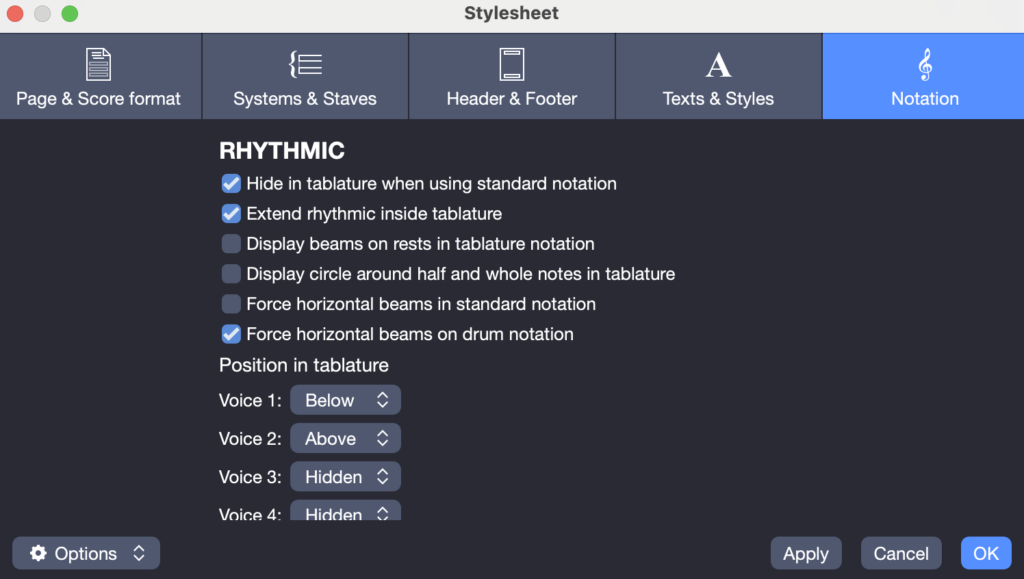


Slash notation for chord grids
If, on the other hand, you’d rather only see the chords along with the rhythm, you can switch to slash notation and activate chord grids (shown above). Here’s how to change your score to slash notation:
- In the right Inspector Panel: Track > Musical notation > Slash notation

Again, once you’ve chosen your preferred notation, take some time to practise just the rhythm. For the newbies reading, if you’re strumming and struggling you can always mute the strings with your left hand and practise getting into the groove of the song.
Once you feel slightly comfortable with it, go ahead and put chords and rhythm together. Don’t worry if it’s not perfect, for now we’re just practising coordinating those two movements together.
5. Break the song into small sections for more effective learning
When trying to learn a new fine motor skill, we need repetition to give our brain a chance to catch on to that new movement pattern.
If you’re running the song from top to bottom, you might be embracing more variability than optimal, and might be making it way harder for yourself. Therefore, the more complex a song, the more necessary it’ll become to break it into small sections. So, here are a few ways you could break down the song into smaller sections for more effective learning:
Section markers
You can start by dividing the song into sections. These often share the same rhythmic patterns and chord progressions, which is exactly what we’re looking for when trying to learn. Section markers will generally appear in your score as verse, pre-chorus, chorus, bridge, etc.
To access section markers go to the Edition Palette: “| A |” icon
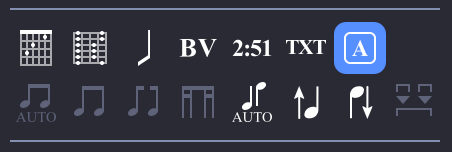
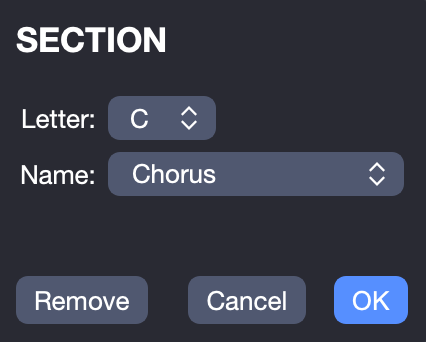
Loop playback
If there’s a specific part you’re struggling with, like a technical riff or a bar chord transition, give it special attention. You can loop that section using loop playback by activating it in the toolbar and selecting the section in question.
You can also adjust the tempo and practise playing it slower, which we’ll discuss in the next step of this guide.

Pro tip: After practising the specific hard part, always practise “uniting it” with what comes before and after. This way you’ll teach your brain to remain calm and confident going into and getting out of the technically challenging parts.
6. Don’t hesitate to slow down the tempo to work on difficult passages
Every guitarist knows: to play fast, you must first practice slow. This essential studying technique helps you build precision and efficiency.
When working on challenging passages, slow down to focus on finger placement and movement optimization. This allows you to eliminate unnecessary motions and develop muscle memory for cleaner playing. As you gradually increase speed, your refined technique will make you faster and more accurate.
Guitar Pro’s features will help you master this process:
Metronome
In the toolbar:
- Activate/Deactivate Metronome
- Metronome & Count-in settings (three vertical dots)

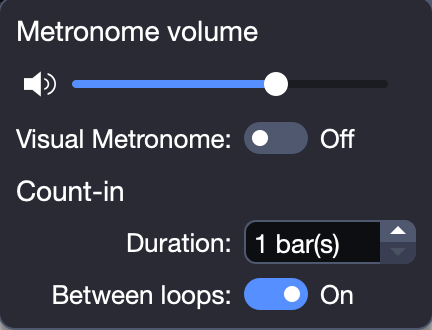
Countdown
It’s always useful to have a countdown when you’re practising (or recording). Here’s how to activate it:
In the toolbar:
- Metronome & Count-in settings (three vertical dots)
- Activate/Deactivate count-in (hourglass icon)

Pro tip: You can add an inter-loop countdown when repeatedly practising looped sections. (It can be especially useful if you’re increasing the tempo of the loop to practise being faster.)
Tempo adjustment
- In the toolbar: Current tempo (quarter note value icon)
- In the toolbar: Relative speed to apply a certain percent of the current speed to the score (90%, 80% and so on)


Guitar Pro speed trainer
Guitar Pro offers an inbuilt speed trainer. With this feature you can choose to practise at a relative speed or a fixed bpm. You can also set it up to automatically increase tempo for a looped section based on the “progressive speed” increase.
For instance, you could set it up to start at 70% of the original speed, having a 10% tempo increase every four repetitions, all the way to the original tempo (100%). Let’s see where to find the speed trainer in Guitar Pro:
In the toolbar:
- Relative speed (Up and Down arrows) to customise the settings.
- To configure the speed trainer precisely, you’ll have to clic on “Custom values” to access the Speed settings window

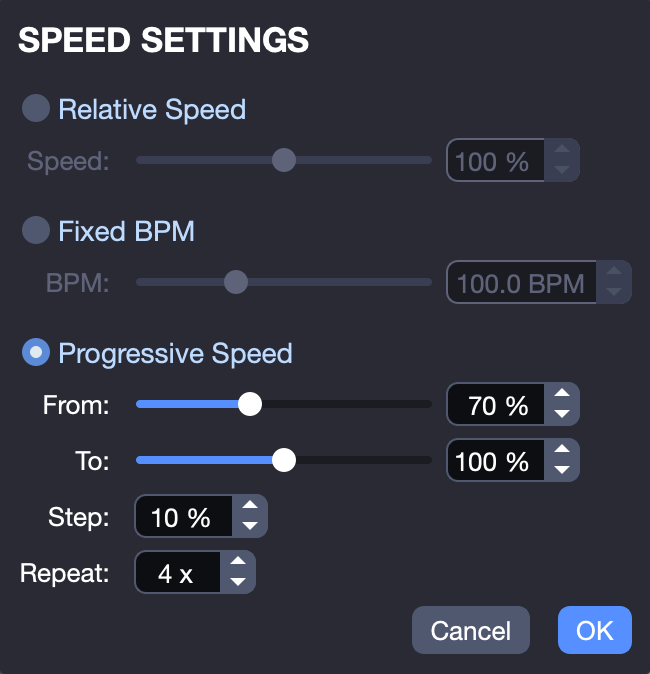
Make use of all these tools and knowledge to practise the song you’ve chosen at different tempos, if you’re patient you’ll notice immense improvements in your technique just by modifying the speed.
7. Practise regularly to gradually master the song
If you’ve made it to this last step, congratulations, you definitely have the perseverance to learn a new skill! Here’s the last best kept secret: you’ve got to put in the hours, practise, practise and more practise. Here are a couple Guitar Pro features that’ll keep you doing just that no matter what:
Focus / unfocus mode
In global view you’ll find all the tracks, you can lower the volume or mute the guitar track you are working on to play along the other instruments.
Audio track feature
Watch this tutorial to learn how to add audio tracks to your Guitar Pro project:
Add a recording (.mp3 or .wav file) via the audio track to synchronise the song with the score and create the ideal learning environment.
See also: How to add an audio file to your scores? Guitar Pro 8 tutorial
Additional Tips to Optimise Your Song Learning on Guitar
Listen to the song repeatedly to immerse yourself and memorise it
Listen to the song, many times, passively, actively, however you want. You could try learning other parts, even if you’re not a singer nor a pianist, give it a go. It’ll transform how you perceive yours, and teach you how to play alongside a band.
Record yourself to identify mistakes and areas for improvement
It’s always good to have an external reference. Think about it as an audio mirror, we might think we’re doing a fantastic job, but discover we’re not really hitting those bass notes when we listen back to it. It’s an easy trick to implement, and it sure is guaranteed to reveal details you were blind to, or deaf, let’s say.
Try to memorise the song without relying on the score
It goes without saying, if you ever want to perform in public you will have to memorise the score. But even if that’s not the case, memorising it will free up space to really dial in on that technique or, to simply enjoy playing!
Conclusion
You now have the building blocks for learning songs faster: choosing the right song, mastering chord transitions, analyzing rhythm patterns, focusing on specific sections, and using tempo control effectively. Guitar Pro supports each step with powerful learning features, realistic audio, and flexible practice tools.
Remember: progress comes from consistent practice. Don’t fear mistakes—they’re essential for learning. Take that challenging song out of the drawer, use Guitar Pro’s speed trainer to master it, and explore mySongBook for accurate tabs.
Share your experience in the comments! Which tips worked best for you? What would you like to learn next?
Thanks for reading, and keep playing!
Download Guitar Pro 8 / Guitar Pro 8 DEMO!
Your questions
With Guitar Pro’s practice tools, most beginners can learn a simple song in 1-2 weeks of regular practice. Complex songs may take 4-6 weeks. The speed trainer and loop features help you progress 2-3 times faster than traditional methods.
Yes! Guitar Pro is designed for all skill levels. The tablature view makes it easy to see exactly where to place your fingers, and features like tempo adjustment let you start slow and gradually build speed as you improve.
Use Guitar Pro’s loop playback to isolate challenging sections, then apply the speed trainer to start at 60-70% of the original tempo. Practice for 10-15 minutes daily, increasing speed by 5-10% each session until you reach full tempo.
Leave a comment
Your email address will not be published.


